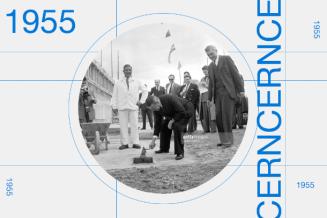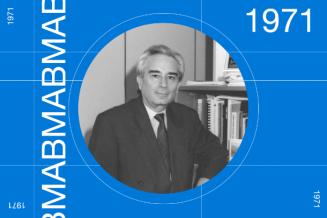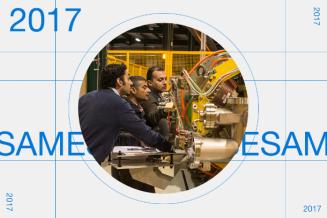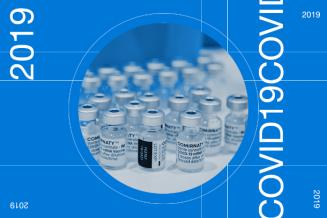Scientific research cooperation: Why collaborate in science? Benefits and examples

The need for a stronger scientific collaboration
It was one of the longest-standing enigmas in art history. For centuries, no one had been able to say for sure that a Madonna and Child painting, often attributed to Raphael, had been directly created by the great Renaissance master himself.
During that time, the painting had changed hands many times. It became the property of popes, was looted by Napoleon during the Italian campaign and in the 1930s ended up in a private collection in Prague, disappearing from public view.
The painting lay almost forgotten until 2020, when a robotic scanner using a particle detector developed at CERN, the European Organization for Nuclear Research, confirmed the brushstrokes on the canvas were indeed Raphael’s.
The authentication of Raphael’s painting through particle detection is just one of the many scientific discoveries that have moved from CERN’s laboratories in Switzerland to daily life, along with the World Wide Web and medical scanners.
Since its foundation in 1954 under the auspices of UNESCO, the complex – one of the largest scientific facilities on earth – has been home to scientists, engineers and students from CERN’s 21 Member States and visiting scholars from other countries.
More than six decades later, CERN has become one the most striking examples of successful scientific cooperation in the world. Its birth was one of the first large initiatives in science and science diplomacy at UNESCO, as well as a diplomatic answer to seek the peaceful benefits of atomic energy after the destruction caused by WW2. Today, CERN has become a model for cooperation in terms of research, embodying the ‘one-earth’ approach that the world needs to tackle the global challenges we are facing.
Places like CERN contribute to the kind of knowledge that not only enriches humanity but provides the wellspring of ideas that become the technologies of the future.
The path of science diplomacy

World War II had not long ended when the idea of scientific laboratories began to emerge under the auspices of UNESCO. It was felt that such endeavours would bring warring nations together, rebuild cooperation and reach scientific excellence.
US Nobel laureate for physics Isidor Rabi’s proposal resulted in the constitution of CERN four years later.
As the world emerged from the ravages of the war, the idea of science diplomacy began to gain traction. In August 1955, the United Nations’ International Conference on the Peaceful Uses of Atomic Energy, known as "Atoms for Peace", was held in Geneva, attended by a delegation from the USSR that included a number of scientists. It was the first time that a large delegation of Soviet scientists working in particle physics took part in a scientific conference in the West. The symposium offered the opportunity for many to make personal contacts. Several Soviet physicists who attended went on to fill important roles in their countries and their work began to be translated into English and published in the West.
Using CERN as a blueprint, global cooperation among scientists became one of UNESCO’s key missions and paved the way to support other institutions that combine scientific excellence with science diplomacy. Science diplomacy helps establish links and strengthen relations between societies, especially where there may not be another official approach. Science is then used to strengthen or build links between countries that have tense or even non-existent relationships.
UNESCO should be the catalyst for the science in the world. I do not mean that UNESCO should run the research centres, but that it should make the initial plans, get them started and see that they are kept going.
Scientific community: linking East and West

Even though the Cold War continued to intensify, scientific cooperation projects were able to demonstrate the capacity of scientific cooperation to forge links between countries and colleagues beyond political or religious considerations.
Ten years after the birth of CERN, UNESCO supported the creation of another venture that would provide a rare line of communication between scientists from the East and the West.
In 1960, a 34-year-old physicist from Pakistan, future Nobel laureate Abdus Salam, suggested the founding of an international theoretical physics institute to help advance scientific expertise.
Salam was convinced that "scientific thought and its creation are the common and shared heritage of mankind". However, at that time, researchers in developing countries, as well as those in smaller countries of the developed world, were often unable to improve their knowledge and sharpen their skills.
His proposal became a reality in 1964 when the International Centre for Theoretical Physics (ICTP) was set up in Trieste, Italy, through an agreement between UNESCO, the Italian Government and the International Atomic Energy Agency.
Over the decades, ICTP has provided scientists from developing countries with the continuing education and skills necessary to further their careers. Many alumni teach at major universities in their countries, lead key research centres and have been recognized for their contributions to science.
Another example of international cooperation in science: a global vision for the Earth’s soil

Amid the successive waves of decolonisation in Africa and Asia, the 1960s became the United Nations Development Decade. At the time, soil erosion – along with the threat it posed to the global food supply – was a main concern for conservationists, just like global warming is today for 21st-century citizens.
The world needed a global map to obtain a comprehensive appraisal of its soil resources. However, no international soil classification existed at the time. Many countries, in fact, had multiple competing regional classifications or were developing their own national systems. Only international collaboration could produce reliable knowledge with worldwide legitimacy and deal with the terminology jungle that until then had undermined international scientific communication.
The Soil Map of the World, backed by UNESCO and the UN’s Food and Agriculture Organization (FAO), began in 1961 – just a few months before President Kennedy proclaimed the 1960s were the Decade of Development at a meeting of the UN General Assembly.
The Herculean project, completed over a span of twenty years and now available in digital form, is the result of a worldwide collaboration between many soil scientists from different countries who worked together to develop a new international classification system. Until recently, it was the only global overview of the planet’s soil resources and a concrete example of the power of scientific collaboration to bring the world together.
Benefits of scientific collaboration: Humanity and the Biosphere

By the late 1960s and early 1970s, global environmental problems had taken centre stage. The post-war economic boom had brought an endless appetite for non-renewable resources, higher levels of pollution and the potential loss of environmental habitats.
In 1971, some 4,000 scientists from around the world warned the UN Secretary-General in the "Menton Message" that there were already far too many people on Earth in proportion to the available resources.
How could human beings continue to develop while preserving the biodiversity that surrounds them? To help answer this question, UNESCO launched the Man and the Biosphere Programme (MAB) in 1971.
One year before the landmark Stockholm conference that spearheaded the concept of sustainable development, UNESCO’s Man and Biosphere programme proposed the creation of some areas committed to the conservation of nature through sustainable socio-economic development, where local cultures and traditions are respected. This was clearly a revolutionary approach to nature conservation, stating that the preservation of nature did not mean the creation of pristine isolated parks and reserves, but the development and promotion of sustainable ways to manage resources and live in harmony with nature. These places were called Biosphere Reserves. Since the birth of the programme, the reserves have promoted the peaceful and balanced coexistence between people and nature, the development of society and the respect for natural and geological heritage. Each reserve supports projects in many different areas, such as sustainable tourism, organic production and, most importantly, scientific investigation.
Through MAB, UNESCO provides a unique platform for cooperation on research and development, capacity-building and networking to share information across 727 biosphere reserves in 131 countries around the world (in 2021), where 260 million people call their biosphere reserves their home. The experiences and Biosphere reserves are "learning places for sustainable development". They provide evidence that living in harmony with nature is possible, and they develop practices and skills to reconcile the people and the planet.
How do scientists collaborate? Science for peace in the Middle East

Middle Eastern countries share many unifying attributes, such as language, religion, history, culture and common aspirations. Throughout recent history, however, development in the region has been held back by political instability and conflict.
Bringing them together to establish an intergovernmental organization that could push aside historical and political differences in the name of science became UNESCO’s mission in the new millennium.
Despite numerous challenges, the International Centre for Synchrotron Light for Experimental Science and Applications in the Middle East (SESAME) became a reality in 2017.
Based in Jordan, the laboratory helps Members of the region’s scientific community carry out world-class scientific research in several fields ranging from biology to archaeology.
Such high-level scientific cooperation is helping to foster a culture of peace in the region. Scientists from the eight full member countries – Cyprus, Egypt, Iran, Israel, Jordan, Pakistan, Palestine and Turkey – are working together within the SESAME community, proving that science can be a common language.
We are trying to build, with the use of science, understanding in the region. The project is very special. Each of us brings its own history, its own wounds, its own scars. Each of us has its own interests, yet we have a common vision, which is to benefit the people of the region and the whole of humanity.
Open science collaboration and innovation for a sustainable future

Humanity continues to face complex challenges that governments and communities cannot solve alone.
The COVID-19 pandemic has highlighted the need to reinforce cooperation, as it has once again reminded us that we all live on one planet. The record speed with which COVID-19 vaccines were developed is due in part to global scientific collaboration.
The dominant view among global leaders is that scientific collaboration is essential to tackle imminent threats such as biodiversity loss, pollution, poverty reduction and the introduction of disruptive new technologies, including artificial intelligence.
To address the complex challenges of the 21st century, science needs to be more transparent, accessible and inclusive. It needs to become open.
Nearly 70% of scientific publications in the world have paid or restricted access. During the health crisis, this proportion dropped to 30% for publications dedicated to COVID-19. This is proof that science can be more transparent and better shared to accelerate research for the benefit of all.
Sharing scientific data on a global scale is a formidable research accelerator - it only took 3 days to decode the genome of the Coronavirus, thanks to an unprecedented collaboration of researchers across borders.
With open science, scientists and engineers can use open licences to share their publications, data, research materials and infrastructure more widely.
By opening traditional science to other knowledge systems, science can be enriched by exchanges with indigenous and marginalized groups for the benefit of all people in every corner of the world.
In 2021, UNESCO adopted the first global recommendation for open science, so that knowledge is no longer the privilege of a minority, but a common good accessible in a more equitable way.
Many scientists have already joined UNESCO in developing the first International Recommendation on Open Science, setting global standards for making open science a reality that leaves no one behind.
However, unrestrained scientific progress is not always ethically acceptable.
The rapid pace of scientific development is not necessarily matched by the various dialogues about its potential impact on society. To address these concerns, since the 1970s, UNESCO has been involved in promoting international reflections on the ethics of life sciences, culminating in the creation of the Programme on Ethics of Science and Technology in the 1990s.
UNESCO regards the human genome as the "heritage of humanity", which should be protected and passed on to future generations. All advances in science need to be considered in the light of human rights.
UNESCO’s initiatives for science
A timeline of our initiatives
1954
CERN - Advancing the frontiers of technology
Every day, thousands of engineers, technicians and scientists work on developing novel technologies and expertise that can be shared with society.
CERN also collaborates with industry – including large companies, SMEs or recent start-ups – and engages with other stakeholders, such as policy-makers, especially those acting in CERN’s Member States.
1961
UNESCO-FAO Soil Map of the World
The FAO Digital Soil Map of the World is the digitized version of the FAO-UNESCO Soil Map of the World produced in a paper version at a scale of 1:5 million. It shows 4,931 mapping units consisting of soil associations, which are mixtures of different soil types.
1964
ICTP
The Abdus Salam International Centre for Theoretical Physics is an international research institute for physical and mathematical sciences that operates under a tripartite agreement between the Italian Government, the United Nations Educational, Scientific and Cultural Organization (UNESCO), and the International Atomic Energy Agency (IAEA).
1971
World Network of Biosphere Reserves
The World Network of Biosphere Reserves of the UNESCO MAB Programme is a network of Biosphere reserves offering solutions for sustainable development in diverse ecological, social and economic contexts. They foster the harmonious integration of people and nature for sustainable development through participatory dialogue; knowledge sharing; poverty reduction and human well-being improvements; respect for cultural values and society’s ability to cope with change – thus contributing to the 2030 Agenda and its Sustainable Development Goals (SDGs).
2017
SESAME
The SESAME international centre for scientific research, a competitive synchrotron light source and the first in the Middle East and neighbouring countries, was inaugurated in Allan, Jordan, on 16 May 2017. This pioneering project, established under the auspices of UNESCO, is the result of fourteen years of hard work, uniting eight countries around a twofold goal – to consolidate scientific excellence in the region and to build cross-border collaboration, dialogue and understanding between scientists with diverse cultural, political and religious backgrounds.
2021
The first international framework on open science was adopted by 193 countries attending UNESCO’s General Conference in November 2021. By making science more transparent and more accessible, the UNESCO Recommendation on Open Science will make science more equitable and inclusive. Through open science, scientists and engineers use open licenses to share their publications and data, software and even hardware more widely. Open science should, thus, enhance international scientific cooperation.

